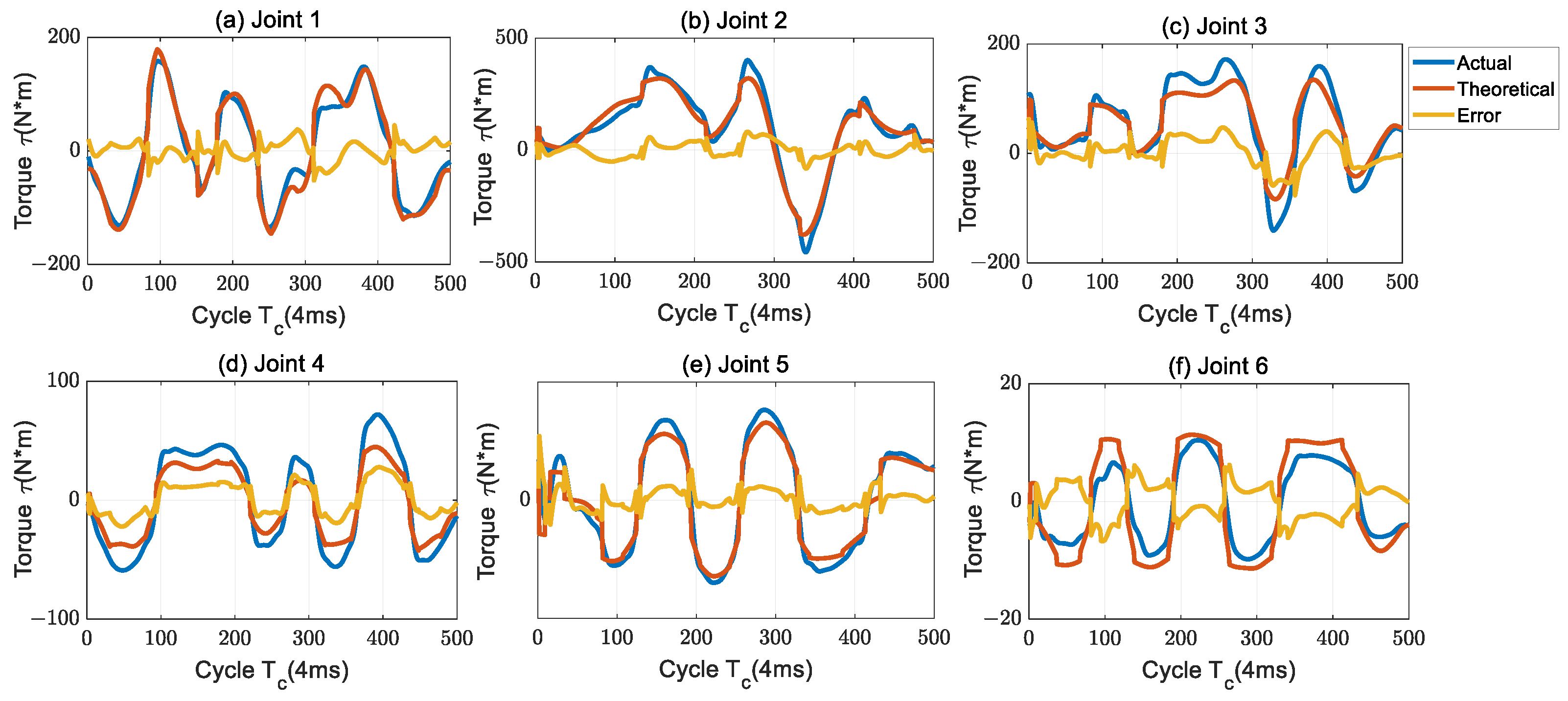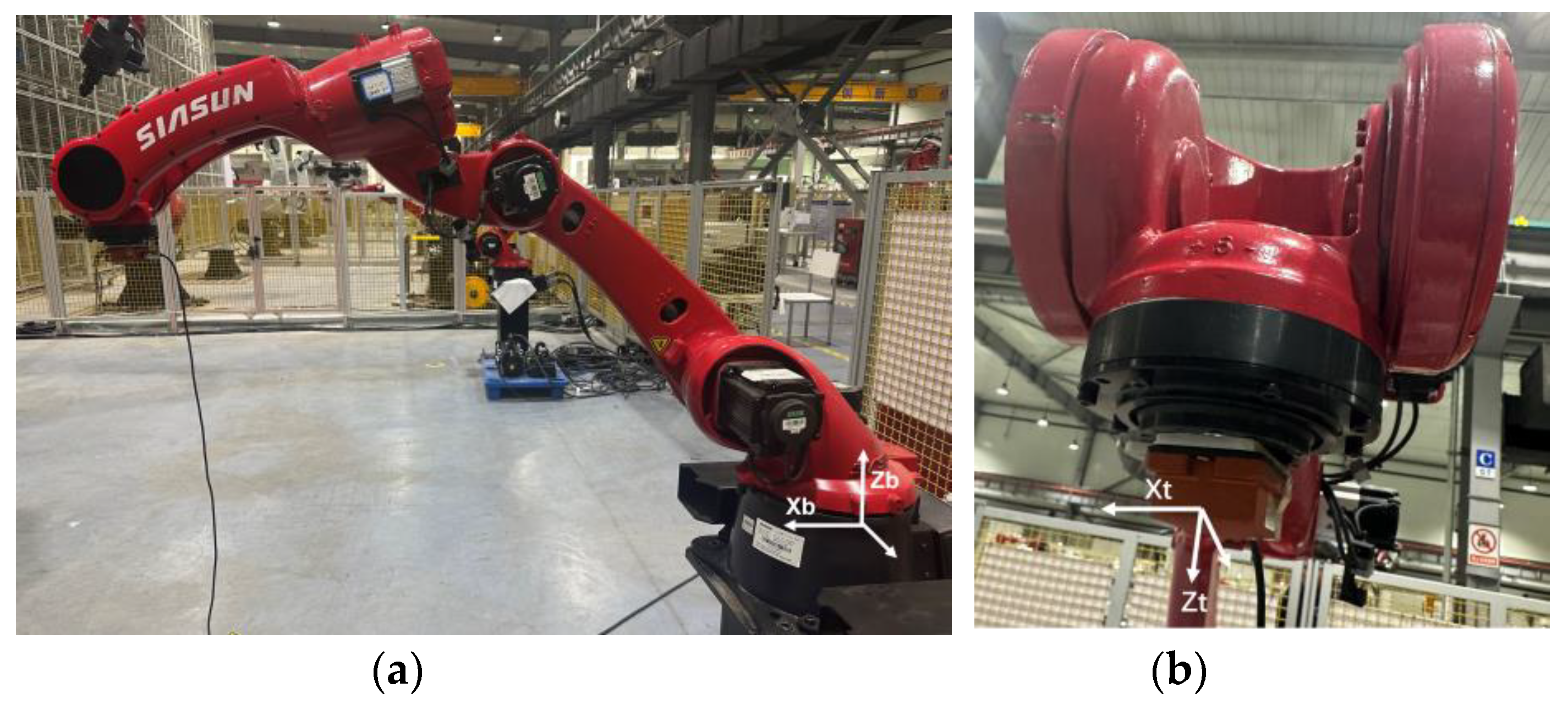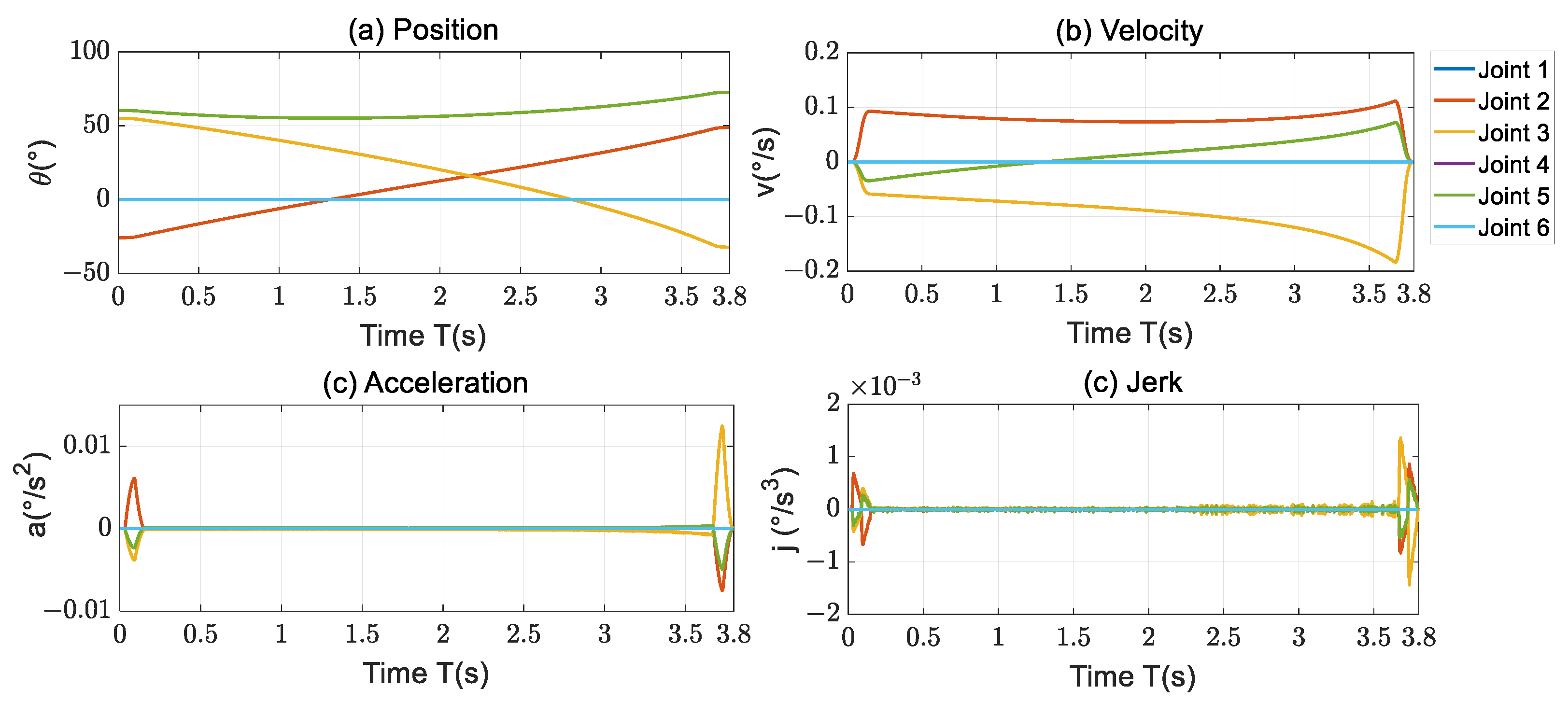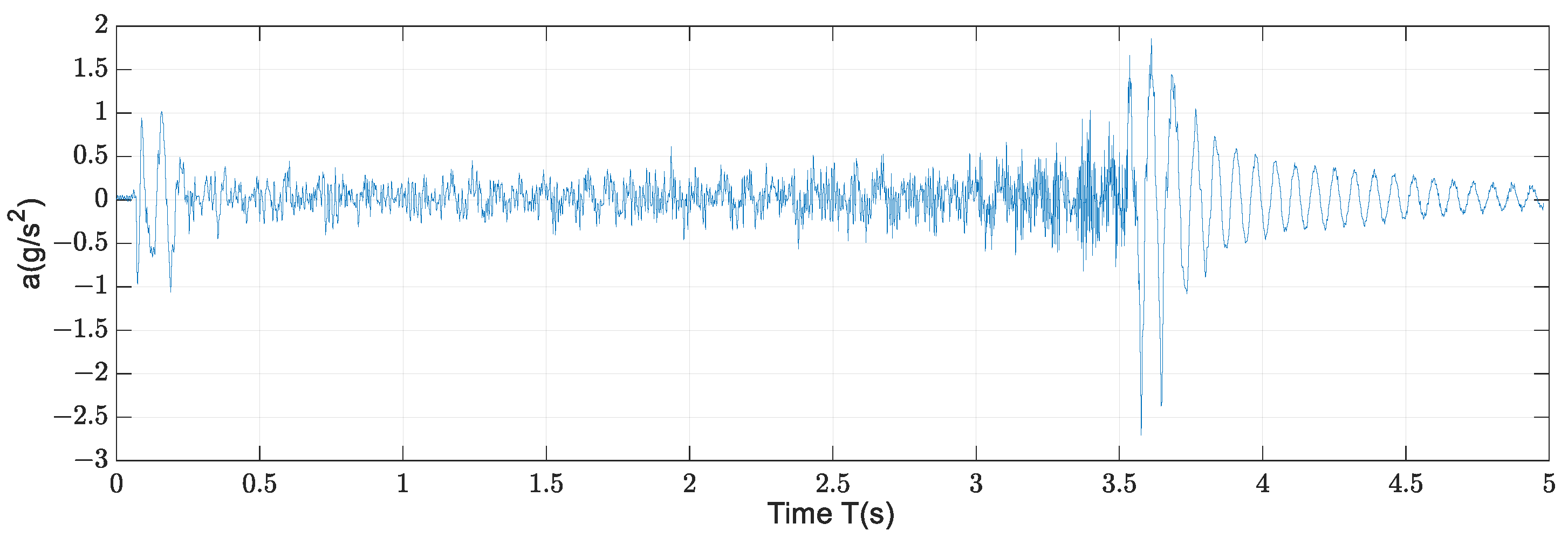A Terminal Residual Vibration Suppression Method of a Robot Based on Joint Trajectory Optimization
Abstract
:1. Introduction
2. Identification of Dynamic Parameters Based on Physical Feasibility Constraints
3. Residual Vibration Suppression Based on the Optimal Trajectory Principle
3.1. Initial Trajectory Discretization
3.2. Objective Functions and Constraints
3.3. Barycentric Interpolation
4. Experimental Verification and Analysis of Results
4.1. Identification of Dynamic Parameters
4.2. Verification of the Performance of Vibration Suppression
5. Conclusions
Author Contributions
Funding
Data Availability Statement
Conflicts of Interest
References
- Bluemel, S.; Bastick, S.; Staehr, R. Robot based remote laser cutting of three-dimensional automotive composite parts with thicknesses up to 5mm. Procedia CIRP 2018, 74, 417–420. [Google Scholar] [CrossRef]
- Tran, C.C.; Lin, C.Y. An intelligent path planning of welding robot based on multisensor interaction. IEEE Sens. J. 2023, 23, 8591–8604. [Google Scholar] [CrossRef]
- Liu, Y.; Zi, B.; Wang, Z.; You, W.; Zheng, L. Research Progress and Trend of Key Technology of Intelligent Spraying Robot. J. Mech. Eng. 2022, 58, 53–74. [Google Scholar]
- Shabana, A.A.; Bai, Z. Actuation and motion control of flexible robots: Small deformation problem. J. Mech. Robot. 2022, 14, 011002. [Google Scholar] [CrossRef]
- Yan, Y.; Guo, Y.; Liu, X. Tooth root crack detection of planet gear in industrial robot RV reducer. Meas. Control 2023, 56, 1720–1731. [Google Scholar] [CrossRef]
- Long, T.; Li, E.; Yang, G.; Yang, L.; Fan, J.; Liang, Z. Trajectory planning of vibration suppression for hybrid structure flexible manipulator based on PSO non-uniform spline interpolation. J. Intell. Fuzzy Syst. 2018, 33, 978–988. [Google Scholar]
- Zhao, L.; Wang, H.; Chen, W. Optimal trajectory planning for manipulators with flexible curved links. In Intelligent Autonomous Systems 14, Proceedings of the 14th International Conference IAS-14, Shanghai, China, 3–7 July 2016; Springer: Cham, Switzerland, 2017; pp. 1013–1025. [Google Scholar]
- Chen, J. Dynamic Performance-Oriented Industrial Robot Control Technology Research. Ph.D. Thesis, Harbin Institute of Technology, Harbin, China, 2015. [Google Scholar]
- Jia, B.; Chen, L.; Zhang, L.; Fu, Y.; Zhang, Q.; Pan, H. Vibration suppression of welding robot based on chaos-regression tree dynamic model. Nonlinear Dyn. 2024, 112, 4393–4407. [Google Scholar] [CrossRef]
- Trung, T.V.; Iwasaki, M. Fast and precise positioning with coupling torque compensation for a flexible lightweight two-link manipulator with elastic joints. IEEE ASME Trans. Mechatron. 2022, 28, 1025–1036. [Google Scholar] [CrossRef]
- Zhang, T.; Hong, L.; Qiang, K. Real-time feedforward torque control of an industrial robot based on the dynamics model. Univ. Politeh. Buchar. Sci. Bull. D Mech. Eng. 2020, 82, 3–18. [Google Scholar]
- Zheng, K.; Zhang, Q.; Zeng, S. Trajectory control and vibration suppression of rigid-flexible parallel robot based on singular perturbation method. Asian J. Control 2022, 24, 3006–3021. [Google Scholar] [CrossRef]
- Khan, R.F.A.; Rsetam, K.; Cao, Z.; Man, Z. Singular perturbation-based adaptive integral sliding mode control for flexible joint robots. IEEE Trans. Ind. Electron. 2022, 70, 10516–10525. [Google Scholar] [CrossRef]
- Rigatos, G.; Abbaszadeh, M. Nonlinear optimal control for multi-DOF robotic manipulators with flexible joints. Optim. Control Appl. Methods 2021, 42, 1708–1733. [Google Scholar] [CrossRef]
- Alam, W.; Mehmood, A.; Ali, K.; Javaid, U.; Alharbi, S.; Iqbal, J. Nonlinear control of a flexible joint robotic manipulator with experimental validation. Stroj. Vestn. J. Mech. Eng. 2018, 64, 47–55. [Google Scholar]
- Yang, G.; Yao, J. Multilayer neurocontrol of high-order uncertain nonlinear systems with active disturbance rejection. Int. J. Robust Nonlinear Control. 2024, 34, 2972–2987. [Google Scholar] [CrossRef]
- Wang, Z.; Zhou, R.; Hu, C.; Zhu, Y. Online iterative learning compensation method based on model prediction for trajectory tracking control systems. IEEE Trans. Ind. Inform. 2021, 18, 415–425. [Google Scholar] [CrossRef]
- Zhao, Y.; Chen, W.; Tang, T. Zero time delay input shaping for smooth settling of industrial robots. In Proceedings of the IEEE International Conference on Automation Science and Engineering, Fort Worth, TX, USA, 21–25 August 2016; pp. 620–625. [Google Scholar]
- Zhao, Y.; Tomizuka, M. Modified zero time delay input shaping for industrial robot with flexibility. In Proceedings of the Dynamic Systems and Control Conference, Tysons, VA, USA, 11–13 October 2017; ISBN 978-0-7918-5829-5. Paper No: DSCC2017-5219, V003T22A003. [Google Scholar]
- Han, Y.; Wu, J.; Liu, C.; Xiong, Z. An iterative approach for accurate dynamic model identification of industrial robots. IEEE Trans. Robot. 2020, 36, 1577–1594. [Google Scholar] [CrossRef]
- Sousa, C.D.; Cortesao, R. Physical feasibility of robot base inertial parameter identification: A linear matrix inequality approach. Int. J. Rob. Res. 2014, 33, 931–944. [Google Scholar] [CrossRef]
- Kelly, M. An introduction to trajectory optimization: How to do your own direct collocation. SIAM Rev. 2017, 59, 849–904. [Google Scholar] [CrossRef]
- Berrut, J.P.; Trefethen, L.N. Barycentric lagrange interpolation. SIAM Rev. 2004, 46, 501–517. [Google Scholar] [CrossRef]
- Swevers, J.; Verdonck, W.; De, S.J. Dynamic model identification for industrial robots. IEEE Control Syst. Mag. 2007, 27, 58–71. [Google Scholar]







| Equipment | Parameter Items | Parameter Value |
|---|---|---|
| Robot | Type | SIASUN T12B |
| Degree of freedom | 6 | |
| Standard load | 14 KG | |
| Scope of work | 1465 mm | |
| Inertial sensor | Type | XSENS MTI-100-2A8G4 |
| Joint | |||||||||||
|---|---|---|---|---|---|---|---|---|---|---|---|
| 1 | 44.876 | 0 | 0 | 44.876 | 0 | 1.476 | 0 | 0 | 0 | 19.965 | 8.8 × 10−7 |
| 2 | 3.102 | −0.843 | −0.696 | 10.001 | −1.549 | 10.089 | 8.828 | 0.517 | 0.371 | 9.261 | 4.245 |
| 3 | 4.140 | 1.608 | 0.873 | 3.305 | 0.215 | 4.170 | 3.899 | 6.325 | 0.811 | 16.031 | 0.757 |
| 4 | 1.724 | −0.126 | −0.393 | 1.758 | −0.313 | 0.257 | 1.505 | 0.018 | −1.768 | 4.489 | 1.505 |
| 5 | 0.480 | 0.015 | −0.099 | 0.489 | 0.074 | 0.032 | 0.007 | −0.005 | 0.035 | 0.002 | 0.156 |
| 6 | 0.005 | −0.007 | 0.006 | 0.019 | 0.002 | 0.020 | 0.129 | 0.052 | −0.049 | 0.965 | 4.422 |
| Joint | ||||
|---|---|---|---|---|
| 1 | 123.382 | 26.457 | 51.442 | 70.107 |
| 2 | 41.718 | 32.308 | 0 | 0 |
| 3 | 35.108 | 32.500 | 0 | 0 |
| 4 | 65.267 | 8.969 | 24.356 | 33.791 |
| 5 | 15.213 | 3.546 | 2.692 | 10.961 |
| 6 | 9.032 | 2.277 | 1.713 | 7.442 |
| Parameter Type | Index | Joint 1 | Joint 2 | Joint 3 | Joint 4 | Joint 5 |
|---|---|---|---|---|---|---|
| P1 1 | RMS (R1) | 14.650 | 22.683 | 13.826 | 6.547 | 2.680 |
| P2 2 | RMS (R2) | 29.388 | 25.806 | 16.875 | 37.783 | 14.737 |
| P1 to P2 | (R2−R1)/R2 | 50.150% | 12.102% | 18.068% | 82.672% | 81.814% |
Disclaimer/Publisher’s Note: The statements, opinions and data contained in all publications are solely those of the individual author(s) and contributor(s) and not of MDPI and/or the editor(s). MDPI and/or the editor(s) disclaim responsibility for any injury to people or property resulting from any ideas, methods, instructions or products referred to in the content. |
© 2024 by the authors. Licensee MDPI, Basel, Switzerland. This article is an open access article distributed under the terms and conditions of the Creative Commons Attribution (CC BY) license (https://creativecommons.org/licenses/by/4.0/).
Share and Cite
Liang, L.; Wu, C.; Liu, S. A Terminal Residual Vibration Suppression Method of a Robot Based on Joint Trajectory Optimization. Machines 2024, 12, 537. https://doi.org/10.3390/machines12080537
Liang L, Wu C, Liu S. A Terminal Residual Vibration Suppression Method of a Robot Based on Joint Trajectory Optimization. Machines. 2024; 12(8):537. https://doi.org/10.3390/machines12080537
Chicago/Turabian StyleLiang, Liang, Chengdong Wu, and Shichang Liu. 2024. "A Terminal Residual Vibration Suppression Method of a Robot Based on Joint Trajectory Optimization" Machines 12, no. 8: 537. https://doi.org/10.3390/machines12080537






